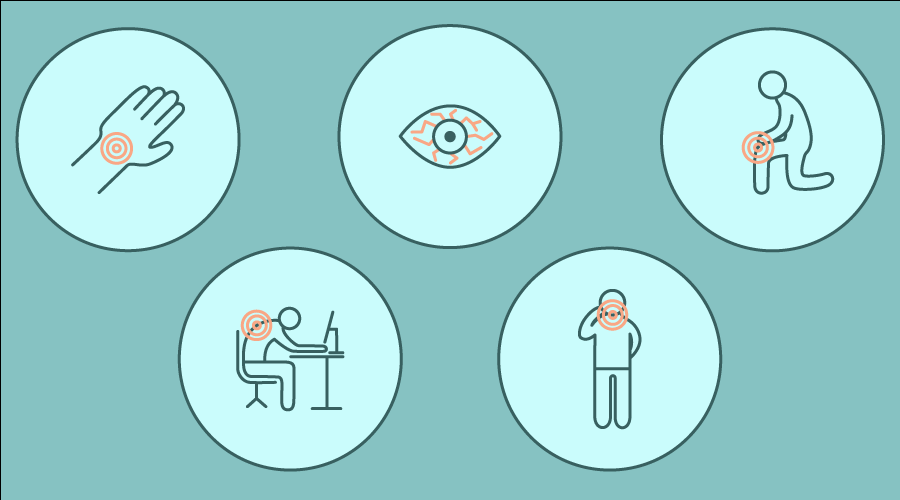If long work hours have left you with persistent aches and pains, you’re not alone. Work-related musculoskeletal disorders, such as tendonitis, muscle strains, carpal tunnel syndrome, tension neck syndrome and low back pain account for one-third of all occupational injuries and illnesses reported by employers every year. Pain, numbness and tingling affect your life at both work and home. Learn how to prevent and treat some of the more common occupational ailments.
Oh, my aching back
Back pain can range from a dull, constant ache to a sudden, sharp pain. Work-related back injuries affect many occupations like nursing, factory jobs and even office work. Poor posture, improper or heavy lifting or repetitive tasks and stress usually cause back pain.
- Prevention: When standing, periodically rest one foot on a low stool. When sitting, choose a seat with good lower back support and arm rests. Keep your knees and hips level and take breaks to move around every 15 minutes. When lifting heavy objects, keep your back straight and bend at the knees.
- Treatment: Over-the-counter pain relievers and hot or cold therapy may provide relief. You may need stronger drugs, cortisone injections, electrical stimulation therapy, physical therapy or exercise.
It’s all in the wrist
Highly repetitive tasks that require wrist bending or stressful wrist postures, such as typing or using small hand tools, can lead to carpal tunnel syndrome. The ache in your wrist may extend to your hand or forearm, and tingling or numbness may develop in your fingers.
- Prevention: Bend and stretch your wrists every 20 minutes. Relax your grip during repetitive tasks and avoid bending your wrist all the way up or down. Practice good posture and don’t allow your shoulders to roll forward.
- Treatment: Frequent breaks, stretching and ice can ease discomfort. Other options include wrist splinting, workstation modifications, medications or surgery.
Pain at the joints
Tendonitis is inflammation or irritation of tendons, which attach muscles to bone. You’ll feel joint pain and tenderness that’s aggravated by movement. Tasks that involve repetitive motion, bending and vibration (using power tools) and repeatedly grasping and turning objects, may cause tendonitis.
- Prevention: Get a proper ergonomic assessment of your workspace to make sure your tendons aren’t being stressed or overloaded.
- Treatment: Rest, ice and over-the-counter pain relievers may help. Your doctor may recommend physical therapy or corticosteroid injections.
A pain in the neck
Neck pain can come from bones, muscles or other parts of your neck or from your jaw, head or shoulders. Poor posture and overuse, such as talking on the phone or hunching over a computer for long periods, contribute to neck pain.
- Prevention: Keep your head centered over your spine. Adjust your desk chair so your hips are slightly higher than your knees. Keep your monitor at eye level. Use a headset instead of cradling the phone in your neck.
- Treatment: Ice and ibuprofen, aspirin or naproxen can reduce inflammation. You may need stronger pain medications or physical therapy.
Source: BlueSpire Strategic Marketing. Published with permission.
